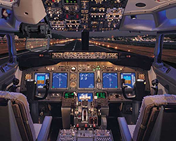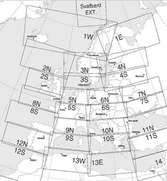Vincent of Plastic Pilot has just posted a story sent to him by a pilot named Jeff who recently experienced a major instrument (Garmin and GPS) failure shortly after take-off that left him GLAD that he had learned how to fly using the old mechanical instruments. The story only further adds to the debate of modern technology (glass cockpits, GPS etc.) verses traditional technology (mechanical gauges etc.) and is a reminder of past stories or advice reported on other blogs.
Flying in Class Bravo Airspace video
Jason Schappert has created and posted a number of short but very useful video podcasts on his site, MzeroA.com (His previous video podcasts include: Understanding and Reading TAF’s, Uncontrolled Airport Operations, How to Read METARS, Runway Signs and Markings, Proper engine run up procedure, Preflighting and Cross country deviations on the fly). His latest video podcast is entitled Flying in Class Bravo Airspace. For European pilots not familiar with the term, “Class Bravo” (or Class B) is the American term for the airspace from the surface to 10,000 feet that is normally found around the busiest and most congested airports. In order to fly in such airspace, a pilot must first contact ATC and receive a clearance to enter the airspace.
Jason proceeds to walk a pilot through the necessary procedures to enter “Class Bravo” airspace and the great part about his video podcast is that he includes actual transmissions between himself and ATC between commentary about entering and flying in Class Bravo Airspace. This video podcast, along with the previous ones he has created are well worth checking out.
Its the lack of concentration that counts
In an entry entitled Flying and Concentration, David Megginson of the Land and Hold Short blog makes the counterintuitive statement that once in the air, its the LACK of concentration that makes a good pilot. Why? Well, David states that when you are flying:
There are lots of things happening at once, and every one seems to need your attention all the time. You simply can’t focus on a single task and finish it. Concentrating on tuning the radio? Guess what, your altitude just changed by 200 ft. Trying to get the gyro compass set correctly? Looks like you just blew through your next checkpoint. Trying to figure out where you are on the map? Maybe you should recover from this incipient spiral, first.
 In other words, his point is that a good pilot must keep his focus moving at all times and NOT concentrate to much on one task or problem. To do so could lead to more unintended problems.
In other words, his point is that a good pilot must keep his focus moving at all times and NOT concentrate to much on one task or problem. To do so could lead to more unintended problems.
Case in point: Remember that commercial airliner that crashed in the Florida Everglades some years ago because the entire crew was concentrated on trying to fix a broken light indicator? They didn’t realize that they had slowly descended to a level just above the ground until it was to late.
So remember, concentration on the ground, especially before a flight during the flight planning stage, is a good thing but to much concentration in the air can in fact become deadly.
Charts or pubs needed by Pilots
 Jason Schappert has a short post on MzeroA.com that is worth mentioning and referring to by those just learning to fly. His entry concerns a common question he and no doubt many other flight instructors and experienced pilots receive as to what types of charts or publications a pilot needs to have. Jason breaks down the charts needed into those that should be carried by visual flight rules or VFR pilots and those that should be carried by instrument flight rules or IFR pilots. For both VFR and IFR Pilots, Jason lists sectional charts and an Airport Facility Directory (AFD) as necessities. In addition, he writes that IFR pilots should also have an IFR Enroute and approach plates.
Jason Schappert has a short post on MzeroA.com that is worth mentioning and referring to by those just learning to fly. His entry concerns a common question he and no doubt many other flight instructors and experienced pilots receive as to what types of charts or publications a pilot needs to have. Jason breaks down the charts needed into those that should be carried by visual flight rules or VFR pilots and those that should be carried by instrument flight rules or IFR pilots. For both VFR and IFR Pilots, Jason lists sectional charts and an Airport Facility Directory (AFD) as necessities. In addition, he writes that IFR pilots should also have an IFR Enroute and approach plates.
Furthermore, even though the miracle of modern technology allows some of these items to be available in electronic format, Jason mentions a story involving one of his students who brought his approach plates in electronic format for a flight only to have his batteries died during training. Moral of the story: A pilot should ALWAYS have a printed copy of any chart or publication handy.
What to ask when choosing a flight school
For readers who are thinking of becoming a professional pilot or for those who are just considering a private pilot license, the Aviations News Blog has posted a helpful top ten type list of good questions to ask when choosing a flight school. These questions have been conveniently organized into the following ten categories: 1) Experience, 2) Quality of instruction, 3) Aircraft training fleet, 4) Programs, 5) Hiring of graduates, 6) Diversity and visa issuance ability, 7) Financing, 8) Weather, 9) Cost of living and life style, and 10) Graduate hiring rates.
Again, some of these question categories are more appropriate for those seeking a professional pilot license. However, even questions about the weather in the location of the flight school and aircraft training fleet being used are important considerations for those seeking to obtain a private pilot license.
Learning to fly the Cirrus SR-22
 I converted to the Cirrus just over three years ago. I use this wonderful plane for most of the trips on my blog GolfHotelWhiskey.com.
I converted to the Cirrus just over three years ago. I use this wonderful plane for most of the trips on my blog GolfHotelWhiskey.com.
On one level, it’s an easy plane to fly and it has many safety systems. On another level, it is sophisticated and complicated with advanced systems. The secret to relaxed flying is preparation and training. This article contains a few tips for would-be Cirrus pilots.
First a bit of background, I’m based at Denham in England and I fly with Freeflight and TAA UK. I have just over 600 hours, a JAR PPL and an FAR CPL/IR.
- RTFM. Read the frakking manuals. It costs nothing but time and this is how I started. Both TAA and Freeflight have a full set of manuals on their websites but you’ll have to register online to access them. You really need to learn a lot of this and I found that writing key points on index cards helped this process.
- Get a good instructor. This is the most important thing, of course. I did my Cirrus conversion with John Page at TAA UK and he is an excellent instructor.
- Use simulators. Use Flight Simulator X, Eaglesoft’s SR22 model and Garmin’s 430 simulator to get familiar with the basic systems. TAA has a sophisticated Flight Sim setup where you can get used to the ‘buttonology’. Don’t worry so much about how to fly the plane, concentrate on learning how the systems interact and what different buttons do.
- Ground school. Do lots. Spend time with an instructor understanding how the plane works. I also spent a few hours at a maintenance company with a Cirrus engineer seeing how all the sytems are maintained and what the plane looks like with the skin off. This was invaluable.
- Start on an SR-20. The SR-20 shares the same basic flying characteristics and avionics with its more powerful sibling. I trained on an SR-20 and it’s a good intermediate step from entry-level Pipers and Cessnas.
- Engine management. It will pay you to learn how to operate the engine in an economic and safe way. Not only can you get more miles per gallon but you can extend the life of the engine. It’s a complex subject but learning when and how to lean the engine is essential.
- Get your priorities right. Aviate, communicate, navigate, Garminate. Set up as much of your route, SID, approach etc. on the ground before takeoff. It’s very easy to spend a lot of time in the Cirrus head down playing with the avionics.
- Join COPA. The Cirrus Owners and Pilots Association is a very active club dedicated to the Cirrus group. Their magazine is always interesting and the online forums are a great learning resource. Although correlation isn’t causation, COPA members are significantly less likely to be involved in a Cirrus crash. Makes you think, doesn’t it?
- Go solo slowly. Don’t finish your conversion and then fly three friends on a long trip. Build up your solo experience slowly. Consider flying with other Cirrus pilots before you start taking passengers. You want to appear (and be!) calm, efficient and in control when people trust their lives to you. Make your mistakes in private!
- Use enroute legs to practice. Long airways legs give you plenty of hours to experiment with the avionics. I use the second Garmin 430 in the planes I fly to practice various scenarios: checking airspace, calculating descent rates, finding the nearest airport etc. etc. Make a checklist of exercises before you go and practice each one until you are fluent in it.
- Aeronautical Decision Making. More systems mean more choices. It’s a good idea to think through various scenarios in advance. For example: when would I pull the chute? Would I use it over water? What would I do if ATC requested maximum speed on an approach? What would I do if my PFD failed at a critical point (this happened to me)? Etc. The FAA’s Risk Management Handbook (PDF) is a good place to start.
- Preflight planning. Besides planning my route carefully and all the usual stuff like NOTAMs and weather, I like to do a weight and balance calculation and risk assessment before I go. The workload in a Cirrus can be quite high so the more you can prepare in advance the easier it will be in the air.
- Treat the plane like a small airliner. The objective is to have standard, high-quality procedures for every step of the flight to achieve maximum consistency.
- Get an instrument rating. The Cirrus likes long-range, airways trips. In Europe, this means getting an instrument rating. It will also teach you better control and accuracy in your regular VFR flying. See my article: How to get an FAA Instrument Rating.
- Get a commercial licence. Getting my CPL helped me improve my core flying skills and it taught me a lot about flight planning and my responsibilities to my passengers. See my article: How to get an FAA CPL.
- Go to CPPP. The Cirrus Pilot Proficiency Program is essential post-graduate school for Cirrus pilots. It includes nine hours of ground instruction and about six hours of flight instruction. Do your conversion, get some hours and then take this weekend course. I’ve done it twice and I learned a huge amount every time.
- Ongoing training. I like to do a training session with an instructor every three months or so.